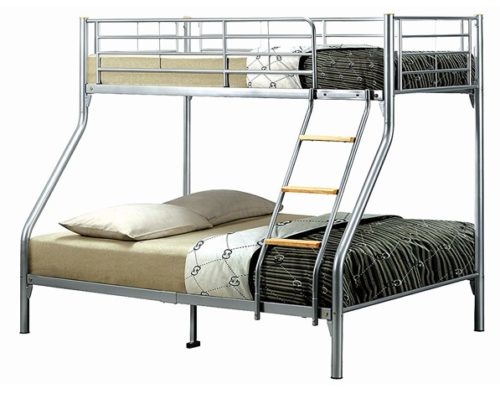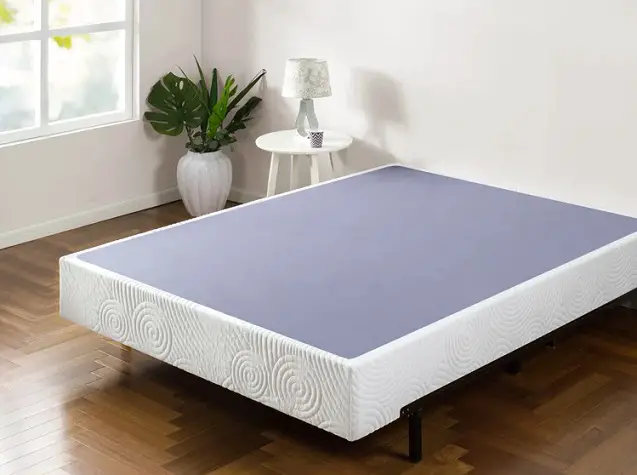Box spring is a type of mattress support system that provides firmness to the mattress and prevents it from mobbing and adding height to it.
A standard box spring is around 9 inches tall and may be made from wood or metal and may contain coils springs or they may be lacking.
A bunk bed is designed in such a way that it does not need a box spring. Box springs are heavy and they will add unnecessary weight to a bunk bed. With an additional height of 9 inches, a bunk bed will become unnecessarily high.
Used on the lower bunk, the box spring will make the mattress high and uncomfortable while used on the upper bunk, it may cause the bed to be too high to climb and may pose a danger from a fall that may cause injuries.
Top bunks usually have rails that are around 9-12 inches high to prevent a fall. When you add a box spring, these guard rails become ineffective and a fall is likely to occur and cause injury.
If you need to add a mattress support system to the Bunk bed, a Bunkie board is the most logical one as it will only add 2 inches to the height of the bed.
Table of Contents
What To Use In A Bunk Bed To Replace Box Spring?
Since we have seen that a box spring will add unnecessary weight and height to a bunk bed, we need to have an alternative mattress support system that will not add too much weight and at the same time will provide enough support.
The mattress support system that you choose to use with a bunk bed needs to be low profile and should not compromise the safety of a bunk bed nor should it void the warranty that comes with most mattresses.
Here we look at some alternatives to box spring in a bunk bed.
1. Slats
Bed slats are usually wooden mattress support systems that come with the bed frame or can be bought separately. Slats have spaces between them and they provide great support.
The space between the slats allows for the mattress to breathe and they are especially useful for foam and latex mattresses.
When the mattress has no free movement of air especially foam and latex mattresses, molds will start forming in the mattress.
Slats need to be closely spaced as when the space between them is wide, the mattress will sag and cause damage.
2. Bunkie Board
A Bunkie board is a mattress support system that is usually thin. 1-2 inches thick that is put underneath the mattress. A Bunkie board is usually covered in a sturdy piece of cloth to make it aesthetic and prevent the mattress from slipping.
A Bunkie board can be made from plywood, particleboard, solid wood, metal, or plastic. A cloth is then put on top.
Bunkie board may be slatted or plain where the slatted type will allow free movement of air and ensure the mattress breathes well.
Bunkie boards are lightweight and do not add weight to the bunk bed and can be used on the upper bunk with no worries about being overweight.
They can be used in conjunction with bed slats, especially where the bed slats are widely spaced and the mattress is sagging between the gaps.
Most Bunkie boards will come in splits for easy movement and storage.
3. Low Profile Box Spring
A low-profile box spring is just like the standard box spring but has a lower height of around 3-5 inches.
Whereas most low-profile box springs will work well with the bottom bunk bed, you need to consider the height of the rails on the upper bunk before adding the box spring.
Consider that on top of the height of the box spring, the mattress will also add height and therefore you need to consider a really low profile box spring for the upper bunk for the safety of the person sleeping there.
4. Plywood
Plywood is made of thin sheets or plies of wood that have been hot glued together. The sheets form a lightweight board that can be used for mattress support in the bunk bed.
Plywood is usually one-eighth to one and quarter inches thick thereby does not add significant height to the bunk bed. It can be safely used on the upper bunk without compromising the safety of the bed.
The choice of the thickness of the plywood will be individual and you can use two pieces of plywood together to make it strong and thicker.
Plywood is lightweight, cheap, and can be easily adapted for anything. You can look at this DIY plywood Bunkie board guide for more information.
The major drawback of plywood is that it’s not strong enough to be used alone to support the bed as it cannot support too much weight.
Plywood being a flat continuous piece is also bad for the mattress as it does not allow proper aeration and may cause the development of molds in the mattress.
Whereas it may be cheap to acquire, and use, it may not be as aesthetically appealing as the ready-made Bunkie board.
Why You Shouldn’t Use Box Springs On Bunk Beds
Although bunk beds are a practical solution for space-constrained households, there are specific considerations that should be taken into account when selecting a mattress foundation to guarantee the safety and comfort of the sleepers.
However, box springs are not a good idea for bunk beds. Traditional beds with box springs are intended to add height and support.
Box springs present a serious danger when used with bunk beds. The most obvious problem with using box springs under a mattress on a bunk bed is that they raise the bed’s surface over the level of the guard rails.
The person sleeping in the top bunk is put in danger by the vast space left between the mattress and the rail.
The use of a box spring on a top bunk also reduces the amount of available headroom in that location. In rooms with 7- or 8-foot ceilings, this becomes an issue for bunk beds.
In the top bunk, the youngster may have trouble turning around or even sitting up because the mattress is raised by the box spring.
Having a box spring under the mattress raises the mattress up to 9 inches and makes it difficult to move between the top and bottom bunks, which is already a problem with most bunk beds.
This may not seem like a big deal, but it prevents children from using the bottom bunk as a sitting area when they get older.
Can A Box Spring Be Used On A Separated Bunk Bed?
Sometimes, bunk beds may be separated and used as individual beds rather than one on top of the other. In this case, you may consider using a box spring as the box spring height will not necessarily be a factor for consideration.
However, it is not a must to use a box spring on a separate bunk bed that is two free-standing beds.
The individual bunk beds may have slats that will support the mattress and if any other support system is needed, a Bunkie board will be enough to prevent the mattress from sagging.
If you need additional height on the separated bunk bed, then a box spring may be used as it will add an extra 9 inches to the bed height. If the bunk beds will be stacked one on top, then the need for a box spring disappears.
Final Thoughts
A box spring provides a great support system to the mattress and adds to the height of the bed but will make a bunk bed dangerous especially the top bunk bed.
It will add unnecessary height and will compromise the safety provided by the bed rails that guard against a fall.
You can use an alternative mattress support system on the bunk beds that will not add height and weight to the bed frame such as Bunkie boards and plywood.


